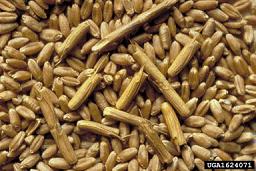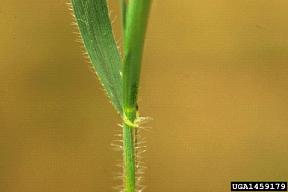
| |
Jointed Goatgrass (Aegilops cylindrica) | |
| |
|
|
| |
|
|
| | Return to the Weed Information Home Page
.
Description
Jointed goatgrass is a winter annual that can reach 1.2 m in height. The leaves are alternate, up to 1.2 cm wide with thin hairs along the margins, sheath openings and auricles. The ligule is short and membranous. Flowering occurs in May to June, when the plants produce red (when mature) or straw-colored spikes. Spikes are cylindrical and contain 2-12 spikelets per spike. The uppermost spikelets have extremely long awns. This species is known to hybridize with wheat. Jointed Goatgrass is listed as a prohibited noxious weed on the Weed Seeds Order under the Seeds Act. Its presence in domestic and imported seed for planting is prohibited by CFIA.
Key Identifiers
- First leaf reddish to brownish green
- Hairy auricles and evenly spaced hairs on leaf edges
- Inconspicuous leaf midrib of the leaf blade
- Narrow and cylindrical spike
Location in Canada
In Canada, two small populations of jointed goatgrass have been discovered and are confined near Port Colborne, Ontario.
Resources
| 
P. Westra, Colorado State University, Bugwood.org |

S. Dewey, Utah State Univ. Bugwood.org |
Similar species
This invasive plant can look a lot like common grasses that grow in Canada which are too numerous to go through each comparison. Wheat is of greatest concern, as it is most likely to be a seed contaminant.
Wheat (Triticum spp.)- Aegilops is morphologically highly distinct from Triticum, with rounded glumes rather than keeled glumes. Wheat also has a conspicuous leaf midrib of the leaf blade. |
|
| |
|
|
| |
For more information about the content of this document, contact Chris Neeser.
This document is maintained by Shelley Barkley.
This information published to the web on April 10, 2012.
Last Reviewed/Revised on August 21, 2018.
|
|